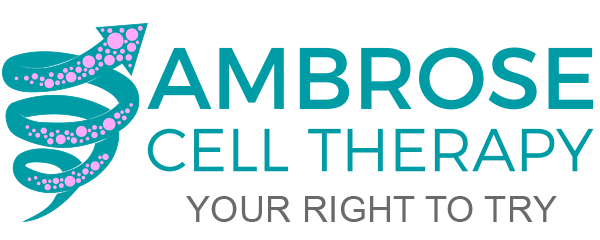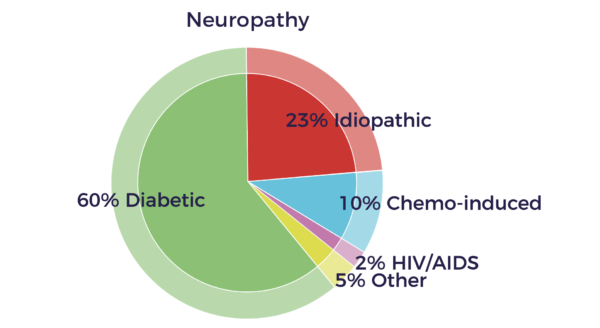Terapia cellulare AMBROSE per la neuropatia
La gestione del dolore è stata a lungo oggetto di attenzione da parte della medicina e la sua storia risale ai tempi antichi. I primi medici egiziani, cinesi e persiani considerarono il dolore come una manifestazione puramente emotiva piuttosto che fisica. Nel corso degli anni si sono evolute diverse teorie sull'espressione e la percezione del dolore, ma solo nel 1924 è stato usato per la prima volta il termine "neuropatia" per descrivere una malattia dei nervi. Oggi si stima che più di 20 milioni di persone negli Stati Uniti soffrano di una qualche forma di neuropatia.
Le ricerche condotte nell'ultimo decennio hanno dimostrato che le cellule staminali e rigenerative di derivazione adiposa (ADRC) sono efficaci nel promuovere la riparazione dei nervi e quindi hanno il potenziale per contribuire a migliorare i sintomi, la funzione e la qualità della vita dei pazienti con danni ai nervi di braccia e mani, gambe, piedi e pelle. [1] [2] [3]
Gli scienziati che hanno studiato le ADRC hanno riferito che questa popolazione mista di cellule riduce l'infiammazione, riequilibra il sistema immunitario, ripristina il flusso sanguigno e rigenera tessuti, nervi e organi. Grazie a molteplici attività biologiche, queste cellule sono state utilizzate in modo sicuro ed efficace in un'ampia gamma di condizioni, tra cui il trattamento della neuropatia. Le ADRC sono come una squadra biologica personalizzata di "pompieri, soccorritori e riparatori" che risiede naturalmente nel nostro corpo. Aspettano in silenzio un segnale di problema - l'infiammazione - e poi si recano in quel luogo per fare il loro lavoro. [4] [5] [6]
Danni ai nervi
Il dolore neuropatico deriva da un danno al sistema nervoso stesso. Spesso è lancinante, elettrico o bruciante, ma è possibile qualsiasi tipo di dolore. Purtroppo, è anche più probabile che porti a un dolore cronico: i nervi non guariscono bene da soli. L'infiammazione a livello sistemico è un elemento chiave nel processo patologico delle neuropatie.[7] Gli effetti della neuropatia dipendono dal tipo di nervi che colpiscono. Molte neuropatie colpiscono tutti e tre i tipi di nervi.
Neuropatia motoria compromette il movimento dei muscoli sotto controllo cosciente, come quelli utilizzati per camminare, afferrare gli oggetti o parlare.
Neuropatia sensoriale cambia il modo in cui percepiamo il tocco leggero, la temperatura, la posizione del corpo o il dolore di un taglio.
Neuropatia autonoma interrompe il controllo automatico degli organi che regolano la digestione del cibo, la respirazione e le funzioni di cuore e ghiandole.
Cause della neuropatia
Lesioni fisiche è la causa più comune di danno ai nervi singoli. Incidenti e interventi chirurgici possono stirare, schiacciare, gonfiare o comprimere i nervi periferici.
Diabete è la principale causa di polineuropatia e può colpire i nervi sensoriali, motori e autonomici.
Scarso flusso sanguigno ai nervi diminuisce l'apporto di ossigeno e provoca danni ai nervi.
Malattie autoimmuni sistemiche (dell'intero organismo)Il dolore neuropatico, in cui il sistema immunitario attacca erroneamente una serie di tessuti dell'organismo, può colpire i nervi. Ad esempio, la sindrome di Sjögren, il lupus e l'artrite reumatoide possono causare dolore neuropatico.
Infezioni e virus come il virus della varicella-zoster (che causa la varicella e l'herpes zoster), il virus del Nilo occidentale, il citomegalovirus e l'herpes simplex colpiscono le fibre sensoriali, causando attacchi di dolore acuto e fulminante. La malattia di Lyme, un'infezione batterica trasmessa dal morso di una zecca, può causare una serie di sintomi neuropatici. Le malattie autoimmuni che attaccano solo i nervi sono spesso innescate da agenti infettivi, come nel caso della sindrome di Guillain-Barré, della polineuropatia demielinizzante infiammatoria cronica e della neuropatia motoria multifocale.
Farmaci possono causare neuropatia, in particolare i farmaci chemioterapici antitumorali.
Tossine chimiche possono colpire il sistema nervoso, come insetticidi e solventi, o metalli pesanti come piombo, mercurio e tallio.
Purtroppo, un gran numero di neuropatie sono idiopaticosenza una causa nota. Diversi nuovi rapporti mostrano ora l'evidenza di anomalie dei nervi periferici nei pazienti affetti da fibromialgia che potrebbero contribuire al loro dolore cronico.[8]
Demielinizzazione - Remielinizzazione
La neuropatia è una malattia neuro-infiammatoria in cui il sistema immunitario attacca l'isolamento (guaina mielinica) dei nervi del sistema nervoso centrale, provocando una demielinizzazione.[9] La guaina mielinica è simile all'idea di rivestire un filo elettrico con un isolante per proteggere il metallo sottostante. Un nervo senza guaina mielinica trasmette l'impulso elettrico nervoso molto lentamente, in modo difettoso o non lo trasmette affatto.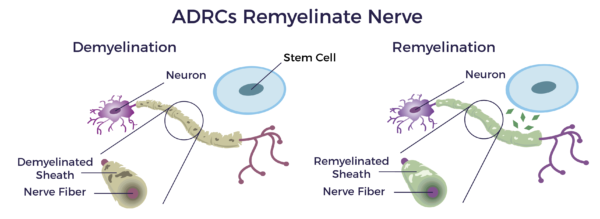
Gli studi hanno dimostrato che le cellule staminali di derivazione adiposa hanno il potenziale di rimielinizzare i nervi demielinizzati associati alla neuropatia e ad altre malattie demielinizzanti.[10] [11]
Risposta infiammatoria-immunitaria
L'infiammazione acuta può essere scatenata da un trauma, da un'infezione, da sostanze chimiche, da tossine ambientali, da scelte di vita (ad esempio il fumo), da fattori ereditari o da una qualsiasi combinazione di questi o altri fattori. Questo tipo di infiammazione è essenziale per la riparazione dell'organismo e di solito è di breve durata e scompare una volta che il processo di guarigione ha avuto luogo.
L'infiammazione è problematica solo quando si protrae, diventando cronica, e colpisce l'intero organismo, diventando sistemica. L'infiammazione cronica e sistemica è spesso una via finale comune della neuropatia.[12] L'infiammazione sistemica è un fattore comune nelle malattie dell'invecchiamento, che comprendono un ampio spettro di condizioni gravi, debilitanti e, talvolta, pericolose per la vita.[13]
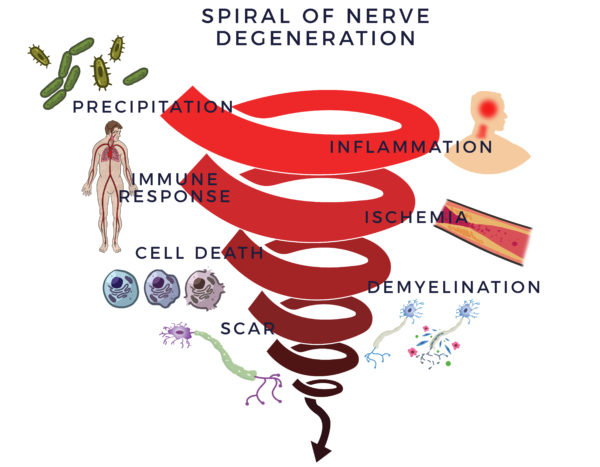
Una risposta infiammatoria avvia un processo vizioso e dannoso. Recluta il sistema immunitario, che ha il compito di combattere le infezioni e altri processi patologici, per favorire la guarigione. Le cellule del sistema immunitario (cellule immunitarie) hanno il compito di proteggere il corpo. Quando percepiscono il nemico, inviano truppe di molecole chiamate "citochine" per combatterlo. Quando questo processo va fuori controllo, si parla di risposta infiammatoria-immunitaria.
La risposta immunitaria equivale ad avere un autista posteriore che reagisce cronicamente in modo eccessivo mentre vi "aiuta" a guidare l'auto. Questo porta a una riduzione del flusso sanguigno (ischemia). Senza una buona circolazione, le cellule muoiono. Nella neuropatia, questo provoca la degenerazione della guaina mielinica, che porterà alla formazione di una cicatrice al suo posto. Questa è la cosiddetta spirale della degenerazione.
Processo di riparazione
Attraverso un meccanismo di comunicazione tra cellule noto come effetto paracrino, le ADRC mobilitano le cellule vicine per lavorare in modo più efficiente.
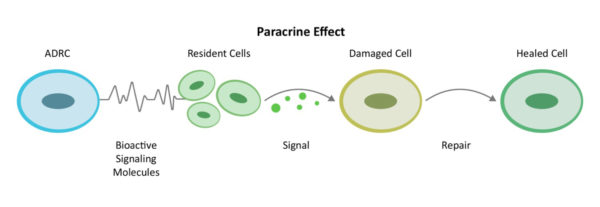
Reclutando altri "riparatori" nel sito (cellule staminali residenti) per tornare al lavoro e fare la loro parte, le ADRC formano una squadra allargata e lavorano innanzitutto per ridurre l'infiammazione e le risposte immunitarie iperattive. Una volta diminuita la guida in retrovia, continuano il loro lavoro aumentando la circolazione con la crescita di nuovi vasi sanguigni, prevenendo l'ulteriore morte cellulare, riducendo le dimensioni della cicatrice e infine la rigenerazione di tessuti e nervi sani.
Questo è il naturale processo di guarigione dell'organismo, che a volte ha solo bisogno di rinforzi. Lo chiamiamo processo di riparazione.
Molecole bioattive
Le ADRC emettono centinaia di molecole bioattive che affrontano i complessi effetti nel sistema nervoso periferico e in altri tessuti e organi colpiti o causa di neuropatia. Molto rilevanti e importanti per la PN sono una famiglia di biomolecole che potremmo considerare come un fertilizzante organico per i nostri nervi. Queste sono chiamate fattori neurotrofici (NTF). (Neuro-, relativo al nervo; –trofico dal greco antico τροφικός [trophikós] che significa "attinente al cibo o al nutrimento").
Le NTF supportano la crescita, la sopravvivenza e la differenziazione delle cellule nervose (neuroni) sia in fase di sviluppo che mature, compresa la nuova guaina mielinica. È stato dimostrato che le cellule staminali di derivazione adiposa rilasciano il fattore di crescita neurotrofico di derivazione cerebrale (BDNF) che promuove la guarigione e la crescita dei nervi. [14] [15] [16] [17]
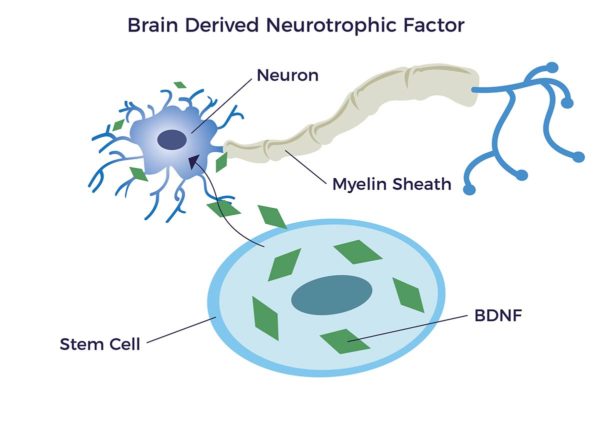
Terapia cellulare AMBROSE per la neuropatia
La terapia cellulare AMBROSE rappresenta un'opzione minimamente invasiva per migliorare i sintomi, la funzione e la qualità della vita dei pazienti affetti da neuropatia. Il protocollo AMBROSE prevede un duplice approccio terapeutico per la neuropatia, che si rivolge sia ai nervi profondi che a quelli superficiali. Il dolore nervoso locale viene affrontato iniettando ai lati dei fasci neurovascolari (perineurale) sotto guida ecografica.
Per favore contattateci per ulteriori informazioni sul trattamento, sulla candidatura e su come diventare un paziente.
[1] T. Lopatina et al. (2011) Le cellule staminali di derivazione adiposa stimolano la rigenerazione dei nervi periferici: Il BDNF secreto da queste cellule promuove la guarigione dei nervi e la crescita degli assoni de novo. PLoS ONE 6(3): e17899
[2] JY Zhou et al Cellule staminali mesenchimali per il trattamento della neuropatia diabetica: un percorso lungo e faticoso dal banco alla clinica Cell Death Discovery (2016) 2, e16055
[3] R Zhang, JM Rosen. Il ruolo delle cellule staminali indifferenziate di derivazione adiposa nella riparazione dei nervi periferici. Neural Regen Res 2018;13:757-63.
[4] JK Fraser PhD e S. Kesten MD Cellule rigenerative di derivazione adiposa autologhe: Una piattaforma per applicazioni terapeutiche Advanced Wound Healing Surgical Technology International XXIX
[5] A Nguyen, A et al Frazione vascolare stromale: Una realtà rigenerativa? Parte 1: Concetti attuali e revisione della letteratura Journal of Plastic, Reconstructive & Aesthetic Surgery (2016) 69, 170e179
[6] Guo et al Frazione vascolare stromale: Una realtà rigenerativa? Parte 2: concetti attuali e revisione della letteratura Journal of Plastic, Reconstructive & Aesthetic Surgery (2016) 69, 180e188
[7] R Pop-Busui et al Inflammation as a Therapeutic Target for Diabetic Neuropathies Curr Diab Rep. 2016 March; 16(3): 29
[8] AL Oaklander et al Prove oggettive che la polineuropatia a piccole fibre è alla base di alcune malattie attualmente etichettate come fibromialgia. PAIN: Novembre 2013 - Volume 154 - Numero 11 - p 2310-2316
[9] A Ellis, D.L.H. Bennett Neuroinflammation and the generation of neuropathic pain, British Journal of Anaesthesia, Volume 111, Issue 1, 2013, Pagine 26-37
[10] A Hedayatpour et al. Promozione della rimielinizzazione mediante trapianto di cellule staminali mesenchimali adipose in un modello di sclerosi multipla con cuprizone. Cell J. 2013; 15(2): 142-151
[11] N Ghasemi Effetti terapeutici delle cellule staminali mesenchimali derivate dall'adipe sul processo di rimielinizzazione nelle malattie demielinizzanti infiammatorie Journal of Histology & Histopathology 2015
[12] S. Amor L'infiammazione nelle malattie neurodegenerative Immunologia, 129, 154-169
[13] C. Franceschi e J. Campisi L'infiammazione cronica (Inflammaging) e il suo potenziale contributo alle malattie associate all'età J Gerontol A Biol Sci Med Sci 2014 June;69(S1): S4-S9
[14] Razavi, Shahnaz et al. "Fattori neurotrofici e loro effetti nel trattamento della sclerosi multipla". Ricerca biomedica avanzata 4 (2015): 53. PMC. Web. 28 settembre 2018.
[15] J. K. Huang et al Rigenerazione della mielina nella sclerosi multipla: Targeting. Cellule staminali endogene", Società americana di neuroterapia sperimentale, Inc. 2011.
[16] T Lopatina et al. (2011) Le cellule staminali di derivazione adiposa stimolano la rigenerazione dei nervi periferici: Il BDNF secreto da queste cellule promuove la guarigione dei nervi e la crescita degli assoni de novo. PLoS ONE 6(3): e178991
[17] S. Seigo et al, Uncultured adipose-derived regenerative cells promote peripheral nerve regeneration, Journal of Orthopaedic Science, Volume 18, Issue 1,2013, Pagine 145-151
